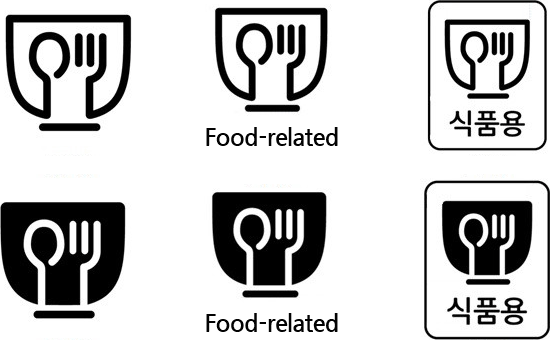Food Labeling System
Food Labeling
- To provide consumers with more accurate information on food products, MFDS implements related regulations and standards* that requires
the labeling of product name, ingredients, manufactured and expiration dates (quality retention date), net contents, identity and principle place of business,
and nutrition information, as well as sanitary instructions for safe storage and warnings on the packaging and container
- *Article 4 and 5 of the 「Act on the Labeling and Advertising of Food, Etc.」
- *Article 5(3) and 6(4) of the Enforcement rule of the same Act
- 「Food Labeling Standards」
Key Function of Food Labeling
- Provides basic information of product *Product name
- Type of food product
- Identity and principle place of business
- Manufactured date, expiration date or quality retention date
- Name and amount of food ingredients
- Country of origin (Please refer to MAFRA, MOTIE, and Korea Customs Service website for details on labeling method)
- Net contents (weight, volume, etc.)
- Provides consumers with information on safety, nutrition, and health *Storage and handling instructions
- Warnings for consumer safety
- Nutrition Information (calorie, carbohydrate, sugar, fat, sodium, etc.)
- For special dietary foods, labeling that can indicate such information
- Method for food sales, promotion and advertisement *Low fat, low cholesterol
- Rich in dietary fiber, etc.
Food Equipment Categorization and Labeling System
- Purpose: This system requires food-related equipment to be labeled with a special label indicating that they have been manufactured as food-related equipment according to the standards specified in the 「Food Sanitation Act」 in order to prevent consumers from getting injured or harmed by using unsafe, non-food-related equipment on foods
- Labeling Subject: Apparatus (or equipment; in direct contact with food) in Article 2 (4) of the 「Food Sanitation Act」
- Tableware, Scissors, Disposable gloves, Bags, etc.
- Labeling Method: In principle, the term 'food-related' or 'food-related mark' must be imprinted by ink or carved on the product package or the product itself forthe smallest package unit of the product, but if this is impossible stickers can be used for the labeling
- Implementation Period: labeling for metal in 2015 → labeling for rubber in 2016 → labeling for synthetic resin in 2017 → labeling for all types of material in 2018

Image of Food-related Mark
Foods for Allergen Labeling and Labeling Method
- Foods for Allergen Labeling: eggs (confined to those from poultry), milk, buckwheat, peanuts, soybeans, wheat, mackerel, crab, shrimp, pork, peach, tomato,sulfurous acid (confined to cases where sulfurous acid is added and the final product includes 10mg/kg or more SO2), walnuts, chicken, beef, squid, clams (including oyster, abalone, and mussels), pine nut
- Labeling Method: If product A used raw materials that contain allergens, and if another product used the substance obtained through extraction or other methods from product A, or food or food additives that contain product A or its substance as its ingredient, then the raw materials must be listed on the label regardless of content. Moreover, a separate allergen labeling must be made near the raw material labeling with a different background color, to list the raw materials that require allergen labeling
- Example: This product contains wheat and milk
- Warning label for possibility of allergen mixture: According to the 「Food Labeling Standard,」 if a manufacturer uses the same manufacturing process for bothproducts that contain and don't contain allergens, this requires the labeling that inevitably there is a possibility of allergen mixture in the contents, as a warning forconsumer safety. In this case, the allergen used as raw material for the product does not need to be labeled
Substantiation of Claims in Labeling or Advertising of Foods
Newly established substantiation of claims in Labeling or Advertising of Foods(established, July 30, 2019)
- Purpose : This Announcement aims to substantiate claims in the labeling and advertising of foods and protect consumers from unfair labeling and advertising by establishing details such as the requirements for substantiating information and methods under Articles 9.1 through 9.7 of the Act on Labeling and Advertising of Foods and Articles 9.1 through 9.4 of the Enforcement Rules of the same Act.
- General requirements : The contents of substantiating information requested by the Minister of Food and Drug Safety shall be directly related to the claims in labeling or advertisement. Substantiating information shall be documented using objective and
Nutrition Labeling
Nutrition Labeling for Processed foods
- Mandatory Food subject
- Retort foods(except livestock products), confectioneries (snacks, candies and sweetened ices, ice creams), breads and dumplings, chocolates, jams, edible oils, noodles, beverages, foods for special dietary uses, fish sausages and ready-to-eat/ready-to-cook foods, soy sauces and pastes, cereals, milk products (milks, processed milks, fermented milks, milk powders, cheeses), hams and sausages.
- Article 6 of the 「Enforcement Rule of Act on Labelling and Advertising of foods」[Annex 4]
- Retort foods(except livestock products), confectioneries (snacks, candies and sweetened ices, ice creams), breads and dumplings, chocolates, jams, edible oils, noodles, beverages, foods for special dietary uses, fish sausages and ready-to-eat/ready-to-cook foods, soy sauces and pastes, cereals, milk products (milks, processed milks, fermented milks, milk powders, cheeses), hams and sausages.
- Mandatory Nutrients - Calorie, sodium, carbohydrates, sugars, fat, saturated fat, trans fat, cholesterol and protein.
- Article 6 of the 「Enforcement Rule of Act on Labelling and Advertising of foods」
- (%) Daily Nutrient Reference Values: Percentage against nutrient reference value per day
Nutrition Labeling for Children's Favorite Foods
- Mandatory Food subject *Businesses(entity running a franchise business who has at least 100 stores) that make and sell hamburgers, pizza, baked goods, and ice-cream among children's foods
- Article 11 of the 「Special Act on Safety Management of Children's Dietary Life」
- Article 8 of the 「Enforcement decree of the Special Act on Safety Management of Children's Dietary Life」
- Mandatory Nutrients
- Calorie, sugar, protein, saturated fat and sodium for each serving
Voluntary Nutrition Labeling of Restaurants and Food Services
- Family restaurants, Snack bars selling ttukbokgi, etc, expressway service stations, amusement parks, snack corners in large theaters, and food courts in departmentstores or large supermarkets have voluntarily implemented nutrition labeling
| Classification | Food Sanitation Act | Special Act on Safety Management of Children's Dietary Life | Livestock Products Sanitary Control Act |
|---|---|---|---|
<Processed Food>
|
<Processed Food> Labeling with color and shape
|
<Processed Food>
|
|
| Target Food |
<Cooked Foods>
|
||
| Subject Nutrient |
|
Calorie, Sugar, Saturated Fat, Protein,
Sodium (5) >Nutrition Labeling for Cooked Food > * Only Calorie can be labeled on menu, etc.
|
|
Genetically Modified Organism (GMO) Labeling System
- MFDS checks products labeled as Genetically Modified Foods in import declaration during the import process for adequate labeling. For GMO products imported as raw materials for one's own manufacturing business, relevant details are notified to the local government of jurisdiction to ensure appropriate follow-up management
- For manufacturing and processing businesses that use products labeled as Genetically Modified Foods as raw material, MFDS reviews relevant documents including IP(Identity Preservation) certificate, or government certificate, or test/inspection report(issued by the agencies designated or deemed to have been designated under Article 6 or 8 of the Act on Testing and Inspection in the Food and Drug Industry) and raw material receipt and payment ledger, and inspects product storage and usage status to check compliance of labeling implementations. When necessary, MFDS also collects and inspects products.
- With the amendment of the Government Organization Act in March 2013, the responsibility for labeling control of Genetically Modified Agricultural Products was transferred from the Ministry of Agriculture, Food and Rural Affairs (MAFRA) to MFDS. GMO (Genetically Modified Organism) management including LMO (Living Modified Organism) related responsibilities were unified to be under the supervision of MFDS, and the two were combined for the establishment of the 「Labeling Standard for Genetically Modified Foods, etc,」 (enacted on April 24, 2014), enabling more systematic management for Genetically Modified Foods.
| Classification | Food Sanitation Act | Agricultural and Fishery Products Quality Control Act |
|---|---|---|
| Legal Provision | Article 12-2 (Labeling of Genetically Modified Foods, etc.) | Article 56 (Labeling of Genetically Modified Agricultural and Fishery Products) |
| Related Notice | Labeling Standard for Genetically Modified Foods | |
| Labeling Subject | - Genetically modified agricultural, fishery, and livestock products - Genetically modified foods (including functional health foods and processed livestock products) using the former as an ingredient, which still contain genetically modified DNA or protein after being manufactured or processed.(not included like foods that go through a high level of refinement and processing and thus do not have any DNA residue such as soy sauce, vegetable oil, sugar etc) |
Food items approved and declared by the Minister of Food and Drug Safety as adequate for food based on safety test results: which are bean, corn, canola, cotton, sugar beet, alfalfa (including vegetables grown using the genetically modified agricultural products, such as bean sprouts and bean leaves). |
| Person Obligated for the Labeling | A person who is engaged in the food manufacturing or processing business, instantly available food manufacturing or processing business, food additives manufacturing business, or distribution-specialized sales business; a person who is engaged in the business of importing and selling imported food; a person who is engaged in the health functional food manufacturing or distribution-specialized sales business; or a person who is engaged in the livestock product processing business or business of distributing and selling livestock products. | A person who produces, ships, or sells genetically modified agricultural, fishery, or livestock products or a person who stores or displays such products for sale. |
| Labeling Method | Non-erasable ink, carvings, or stamps shall be used for labeling. A sticker or label sheet may be used, but they should not come off. Moreover, the labeling shall be done in a vivid color distinguishable from the background color of the container or packaging using a 12 pt font or larger to ensure that consumers can easily see the information.Labeling must include the expression 'Genetically Modified Food' or 'Food including Genetically Modified OO.' If use of genetically modified raw materials cannot be confirmed, then this can be labeled as ‘Possibly contains Genetically Modified OO.' | Labeling must be clear and differentiated from the color of the background package, ink-printed, carved, marked or in stickers, written in fonts larger than size 12.When item is sold individually or without package, labeling must be done with signboards or information displays.Labeling must be expressed as 'Genetically Modified OO' or 'Including Genetically Modified OO,' etc. If genetically modified agricultural or fishery product may be included, this can be labeled as 'Possibly contains Genetically Modified OO.' |
Health Functional Food Labeling System
To enhance quality of health functional foods and to provide consumers with accurate information, the MFDS implements related laws and regulations*that require health functional foods to have the right mark and label while providing information on product name, raw materials, expiration date, identity and principle place of business, and product functions. Health functional foods are also required to add intake instructions on their containers and packages
- * Article 6 of the 「Enforcement Rule of Act on Labelling and Advertising of foods」[Annex 4]
- * 「Labeling Standards of Health Functional Foods」
Items Required in Product Labeling
- Emblem of Health Functional Food

- Product name
- Identity and principle place of business
- Expiration date and storage method
- Contents
- Nutrition information
- Functional information
- Intake instructions including intake amount and method
- Raw material contents
- Expression that this product is not a pharmaceutical product used for disease prevention or treatment
- The labelling of precautions for consumers’ safety
- 「Labeling Standards of Health Functional Foods」
Labeling of Functional Information
- Only the functions recognized by the health functional food standards and specifications, or functions individually recognized by the MFDS can be labelled on the products.
- Labeling and advertising of health functional food must pass the review of labeling and advertising by voluntary review board.


